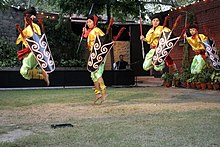
Back হুয়েন ল্যাংলন Bengali/Bangla Tang-ta Czech Thang-ta Danish Thang-ta Spanish タンタ (格闘技) Japanese താങ്-താ Malayalam ꯍꯨꯢꯌꯦꯟ ꯂꯥꯂꯣꯡ MNI Thang-ta Polish
| Also known as |
|
|---|---|
| Country of origin | |
| Creator | Nongda Lairen Pakhangba (according to Meitei tradition) |
| Olympic sport | No |

Huiyen Lallong is a traditional Meitei martial art form. It is one of the Indian martial arts, originating from Manipur.[1] In the Meitei language, Huiyen means war while Lallong or Lanlong can mean net, knowledge or art. Huiyen Langlon consists of two main subforms: Thang-Ta (armed combat) and Sarit Sarak (unarmed fighting). The primary weapons of Huiyen Lallong are the Thang (sword) and Ta (spear). The spear can be used in its non-missile form while up close, or thrown from afar. Other weapons include the shield and the axe. Unarmed combat incorporates hand strikes, kicks, and grappling (Mukna). Because of Manipur's cultural similarity and geographical proximity with Myanmar, huyen langlon is closely related to Burmese bando and banshay.
The Thang-Ta aspect of huyen langlon can be practiced in three ways: ritual, demonstration, and combat. The first way is related to tantric practices and is entirely ritualistic in nature. The second way consists of a spectacular performance involving sword and spear dances. These routines can be converted into actual fighting practices. The third way is the true combat application.
Thang-Ta shares a connection with certain war-dances, often blurring the line between dance and combat forms, such as Thang-hairol (sword dance) and Khousarol (spear dance). Many ritualistic dances in Manipur were traditionally performed by martial artists such as the spear dance for funerals or the sacred Thenkou dance. The sword movements in dance are meant to either symbolize protection or to ward off evil spirits.[2] As a result, it is part of the Manipuri classical dance.[3][4][5]
- ^ Thang Ta - the martial art dance Archived 22 June 2013 at the Wayback Machine, India-north-east.com
- ^ "Thang Ta: Martial Art of Manipur".
- ^ Chowdhurie, Tapati (13 May 2016). "Gem of a journey". The Hindu.
- ^ https://www.esamskriti.com/essays/pdf/14-dec-manipuri-dance-a-journey.pdf Archived 26 April 2022 at the Wayback Machine[bare URL PDF]
- ^ "Manipuri dance elbowed out by Bharat Natyam, Odissi, Kathak". 22 February 2014.